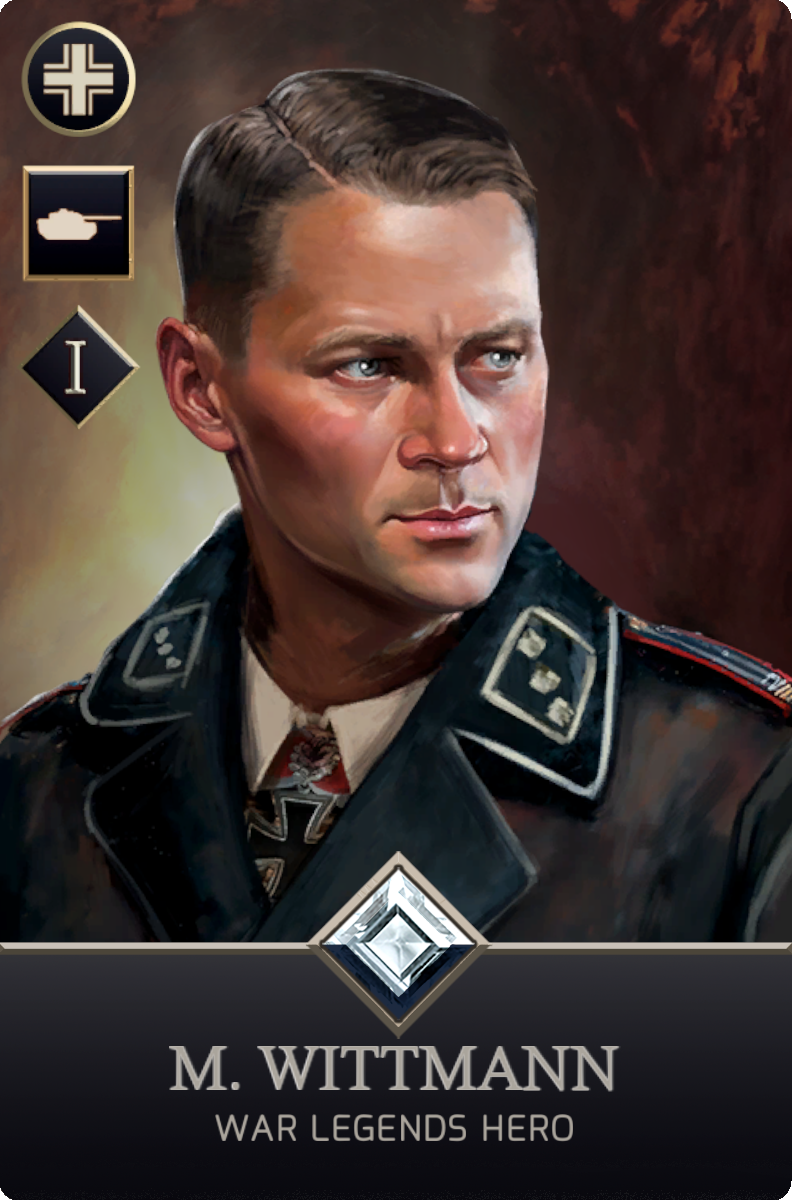


Hero Background
Michael Wittmann was born on 22 April 1914 into a humble farming family. Wittmann went to school, and at the age of 16 he started working on the family farm for a few years, in 1933 he decided to leave the farm and looked for work for months without results, so he decided to enroll in the Reich Labor Service (Rad) for 6 months, after this period Wittman joined the army in 1934, where he was assigned to the 10th company of the infantry regiment, where he saw a Panzer for the first time in his life, which left a deep impression on him.
In 1936 Michael left the army and went into construction, but this period was short, as he managed to join the SS, where, thanks to his driving skills, he was assigned a small reconnaissance vehicle with which he took part in the annexation of Austria. After this he gained recognition and promotion to Sergeant II.
In 1939 during the invasion of Poland, Wittmann was in the armored vehicle platoon which again brought him recognition due to his great combat performance, after returning from Poland he was promoted to Warrant Officer Training, but this period lasted until he was transferred to the armored scout company where he was assigned his first armored car, a Sturmgeschütz III.
During Operation "Barbarossa" in 1941 and under orders not to engage in combat, he was ordered to drive his Sturmgeschütz III, a vehicle clearly inferior to the Soviet T34, up a hill. He then discovered a platoon of two squadrons of Soviet T34 tanks, one squadron containing six units and the other twelve.
Ignoring the order not to engage in combat, he waited for the first T34 to come up the hill on the opposite side and as soon as it appeared in his field of view he shot it between the turret and the chassis with devastating results for the T34, one by one he did the same with the remaining ones, thus finishing off the first squadron of six T34 units.
The other squadron of twelve units, which took a different path, was also annihilated with the same strategy, resulting in the destruction of 18 T34 units. Wittmann's humanity was shown by the fact that on one occasion the surviving crew of one of the T34s emerged from the car engulfed in flames, Wittmann extinguished the flames and provided good medical care for the surviving crew.
For his military action, bravery and humanity in this operation he was awarded with the Iron Cross II Class and sent to Germany for training as a WaffenSS officer. He was also assigned the brand new Tiger, considered the best tank in all of WWII.
Again in 1943, Michael Wittmann was sent to the Russian Front, this time in command of a small squadron of five Tiger tanks. The Russians had practiced a multitude of defensive lines with T34s, which was to Wittmann's advantage as his forte was fighting tanks on the move. Wittman advanced, destroying every tank that got in his way. By the end of the day he had destroyed 12 anti-tank guns and 8 T34 units.
Arriving at the last Soviet defensive line near a village called Prokhorovka, the Germans were stunned as a horde of hundreds of T34 tanks advanced towards them without stopping. Despite the superiority of the Tiger tanks, the T34s continued to advance, resulting in a German retreat. By the end of the campaign, Witmann had destroyed 117 armored vehicles and anti-tank guns. Wittmann was promoted to lieutenant and awarded the Iron Cross, and weeks later received the oak leaves from Hitler himself.
After this battle, Wittmann married and was stationed in France, where he spent a quiet period of time.
In the summer of 1944 the Allies landed on the beaches of Normandy. Days earlier, Allied planes had bombed the German defenses so that no more than 6 German tanks remained operational when Wittmann arrived at his new destination.
On his way to Villers-Bocage, Wittmann was informed of a large enemy convoy, but he couldn’t call for reinforcements as he would be discovered, so he opted to ambush them. This opportunity came up when the British soldiers dismounted from their armored vehicles for breakfast. Wittmann, in command of his Panzerkampfwagen VI Tiger unit, destroyed the British 7th Armored Division, which amounted to 14 tanks and 15 transport vehicles along with 2 anti-tank guns, in 15 minutes.
Arriving at the town of Villers-Bocage, Wittmann and his crew, at the controls of the Panzerkampfwagen VI Tiger were ambushed by 8 British Sherman Firefly units, their tank was immobilized by a shot from one of the Fireflies. Wittmann and his crew managed to shoot down 3 units under these circumstances but the remaining 5 started firing at them from all sides, killing him and his crew.
Michael Wittmann was killed in action on 8 August 1944 at the age of 30.
He died in 1981.








